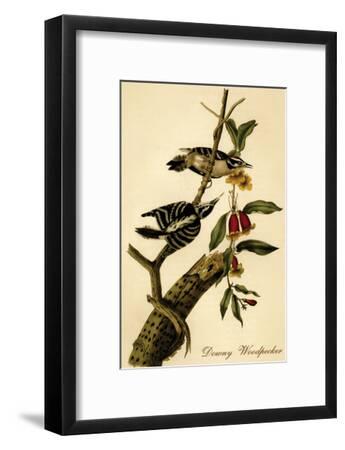
Before then eagles were widespread in Maine. So while bald eagles are causing declines in other bird species, let’s keep in mind that it was our use of pesticides that almost wiped them out. Now we get to see them by the dozens, and perhaps this will be the year we top our previous high count of 66 in one morning! I mention this because the history of that trip goes back to its first run, in 1969, when the trip was started as an opportunity to see ONE eagle nest.
#Audubon downy woodpecker plus
18 this year, Maine Audubon will be running its annual “Bald Eagles of Merrymeeting Bay” boat trip out of Boothbay, an opportunity to see many eagles and other birds, plus discuss conservation efforts in the area. Thanks to conservation efforts, and legislation like the Endangered Species Act, we now have our national symbol commonly soaring over our skies. The nest cams (nesting is over for this season) have captured some amazingly gruesome, but totally natural, attacks of bald eagles on the osprey nest at Hog Island over the years.ĭespite the predation on our beloved loons and herons, we should keep in mind that we almost lost our eagles not that long ago. Even other predators, like osprey, are having nests raided by bald eagles. These include great blue herons, common loons, and great cormorants (these cormorants are now on Maine’s threatened species list and shouldn’t be confused with the ubiquitous double-crested cormorant). The loon population has also declined.” As Christine notes, there are a number of birds feeling the pinch due to increased eagle predation, mostly those that nest near the water. Although their tongues are structured and function quite differently, it doesn’t take too much imagination to see the correlation between these two long-tongued birds and their ability to access sugar water in hummingbird feeders.Ĭhristine writes, “At our camp up north, we’ve noticed baby ducks and mergansers decline over the course of the summer to a greater degree now that there is a strong eagle presence on the lake. These long tongues help hummingbirds reach nectar in deep flowers, and help woodpeckers pull insects from holes in trees. Both hummingbirds and woodpeckers have long tongues, so long that they actually have to split and wrap around the skull back toward the nostril. Perhaps it takes some learning, like watching or following a hummingbird, for a woodpecker to know to feed from something as novel as a (typically) plastic container with holes in it.Ī final thought on this subject: Woodpeckers have one trait very similar to hummingbirds, which makes them especially well suited for using hummingbird feeders, and that’s their tongue. It is well known that hummingbirds will follow yellow-bellied sapsuckers to their fresh wells, especially in birch trees in the spring, for an easy sap meal when flowers are scarce. That makes sense for attracting hummingbirds, but not much for the woodpecker. There’s a fun spinoff question to this: How did the woodpecker learn to go to the hummingbird feeder in the first place? Most hummingbird feeders are made to resemble flowers in some way, be it their color or shape of the feeder openings.

This is one reason why pileated woodpeckers are less common feeder visitors most are just too small for them.

Typically, woodpeckers like to have a long vertical piece below a food source for them to perch on and prop their tail against. I suspect more birds would do it too, or even that woodpeckers would do it more often, if hummingbird feeders weren’t so difficult for them to perch on. And why not? It is a reliable, often abundant, source of sugary food.

Some other songbirds like chickadees are occasionally seen drinking from hummingbird feeders. The short answer is that this is perfectly fine and normal for woodpeckers.


 0 kommentar(er)
0 kommentar(er)
